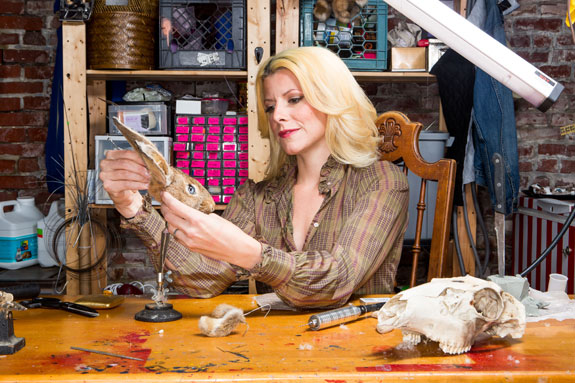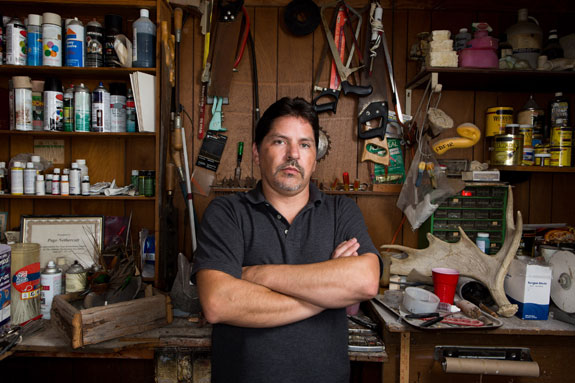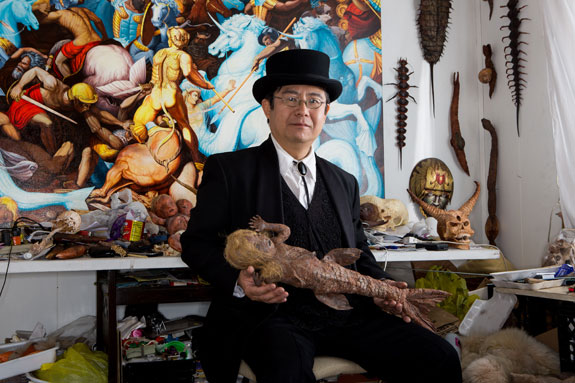Outrageous Taxidermy, the Subject of a New Show on AMC
Former Smithsonian taxidermist Paul Rhymer is a judge on “Immortalized,” a TV competition that pits up-and-comers against superstars in the field
![]()
Taxidermy: dying trade or resurgent art form? As an outsider—I have never hunted, let alone stuffed and mounted an animal—I was tempted to think the former. Then, I spoke with Paul Rhymer, a former Smithsonian taxidermist and model maker.”Taxidermy is alive and well,” he says. “Commercial taxidermy, for hunters, has probably never been stronger than it is now—and probably never been better. The skill levels have just gotten so good with all the different advances in materials and techniques.”
Rhymer is a traditionalist. He hails from the museum world, where he spent 26 years (1984 to 2010) creating realistic taxidermy for display at Smithsonian’s National Museum of Natural History in Washington, D.C. Rhymer and his colleagues produced 274 mounted specimens for the museum’s Behring Hall of Mammals, which opened in 2003; he also had a hand in the now four-year-old Sant Ocean Hall. A bunch of his critters—a maned wolf, a grévy’s zebra, several primates and a pair of penguins, among others—still inhabit the museum. When he wasn’t making new mounts from donated animal carcasses, he was restoring existing ones. In 2002, he gave the museum’s panda a dye job, bleaching its yellowed hair white and dying it’s dark fur a deeper black.
But, even with his institutional background, the second-generation taxidermist is quick to express his appreciation for a new sect of bold artists working in the field. Armed with the know-how to skin, clean and stuff animals, these “rogues” place animal specimens in fantastical contexts; they even build strange hybrids of different species. “This element has been around for a very long time too. You have Victorian guys making whole wedding scenes with little kittens dressed up in wedding dresses,” says Rhymer. “But rogue taxidermists are just taking it to another level.”
“Immortalized,” a new television show premiering on AMC tonight (10/9c), pits taxidermists of both types against each other in what its host, Zach Selwyn, calls “creative combat.” I was able to screen two kooky episodes in the series’ first season, and although the show seems to lack the shiny finish one might expect from a big network, I have to admit I got a kick out of its premise. Oh, and its tagline too. “Immortalized,” says Selwyn, at the close of each segment, “where it is not whether you win or lose, but how you display the game.”

Immortalizer Dave Houser is a self-taught taxidermist and the owner of Truetolife Taxidermy in Marysville, Pennsylvania. Photo courtesy of Ben Leuner/AMC
The concept of the show is this: There are four superstars in taxidermy—two traditionalists and two rogues—who, for the purposes of the show, are called “Immortalizers.” Each episode, one Immortalizer takes on an outside “Challenger.” The challengers, like the veteran immortalizers, can be artists or commercial taxidermists. The two contestants are given a theme—some examples include “End of the World,” “First Love” and, the even more confounding, “Self Portrait.” They prepare a piece at home over the course of a few weeks and then return to the studio for a face-off. Rhymer was tapped to be one of three judges; he is joined by artist-taxidermist Catherine Coan and the nasally-voiced comedian, actor and writer, Brian Posehn. Together, the trio scores each submission on craftsmanship, originality and adherence to the theme in each submission, and the total score determines the winner.

Rogue taxidermists, according to the new show, are “makers of macabre menageries that push the very boundaries of reality.” Immortalizer Beth Beverly studied jewelry design at Tyler School of Art and then acquired taxidermy skills at Bill Allen’s Pocono Institute of Taxidermy. Photo courtesy of Ben Leuner/AMC
“I thought this could really be a lot of fun, and it was! I had a great time doing it,” says Rhymer. “I have my favorites. But, I thought that, by and large, the work that all of the taxidermists brought to it was really, really neat.”
Rhymer has competed extensively at taxidermy conventions, but “Immortalized” was different. “The competitions I had been to in the past were ‘mount this duck,’ ‘mount this fish,’ ‘mount this deer.’ These were much more open to the imagination, and just much crazier scenarios. Someone put a lot of thought into figuring out which themes would really produce some provocative pieces,” he says.

Immortalizer Page Nethercutt prepared his first-ever mount—a squirrel—for his elementary school science fair. Photo courtesy of Ben Leuner/AMC
In one bout, immortalizer Page Nethercutt, the award-winning proprietor of Moore’s Swamp Taxidermy in New Bern, North Carolina, and challenger CJ Fegan, an up-and-coming taxidermist from Edgewater, Maryland, presented two very different pieces meant to convey the same theme, “End of the World.” Nethercutt created a mount of a fierce bobcat attacking a quail; Rhymer describes it as “very intimate, natural, very precise.” Then, in the opposite corner, Fegan prepared a “sci fi and epic and colossal” scene capturing multiple animals in a panic.

Immortalizer Takeshi Yamada is a rogue taxidermist living and working on Coney Island, New York. He has been making freakish animal hybrids since he was a kid. Photo courtesy of Ben Leuner/AMC
Taxidermy is a unique blend of science and art. Any taxidermist with years of experience will have a solid understanding of animal anatomy. But that alone does not make for great mounts. “As an artist,” adds Rhymer, “you have the deer head that is just sticking on the wall and it is looking straight ahead, or there is a way of creating that thing, mounting it and doing something that is not only natural and scientifically accurate but also beautiful.”
Rhymer hopes that “Immortalized” will show that someone who prepares taxidermy can still respect animals. “I would like the general population to see taxidermy in a new light,” he says, “that it’s not just rednecks who do it and that even we who define ourselves as rednecks, and I count myself among them, have a real deep appreciation for wildlife.”
/https://tf-cmsv2-smithsonianmag-media.s3.amazonaws.com/accounts/headshot/megan.png)

/https://tf-cmsv2-smithsonianmag-media.s3.amazonaws.com/accounts/headshot/megan.png)